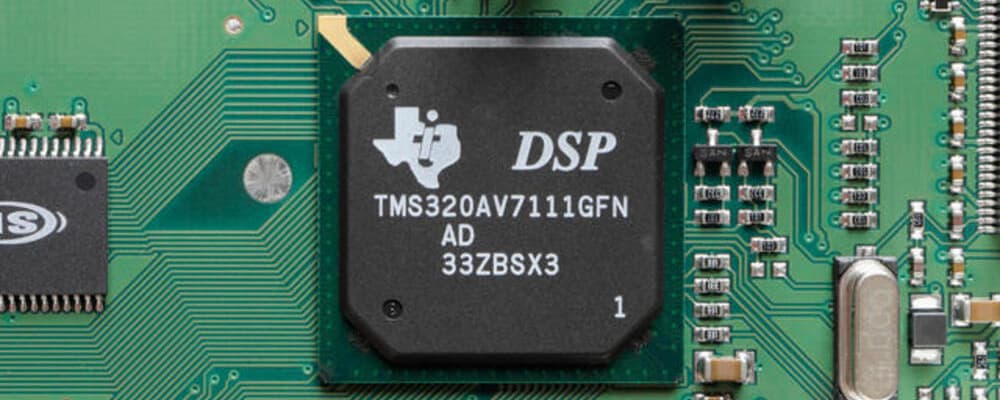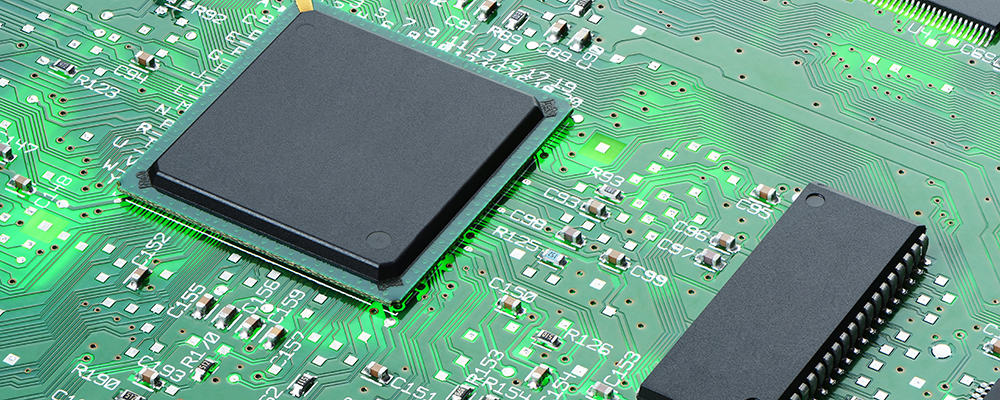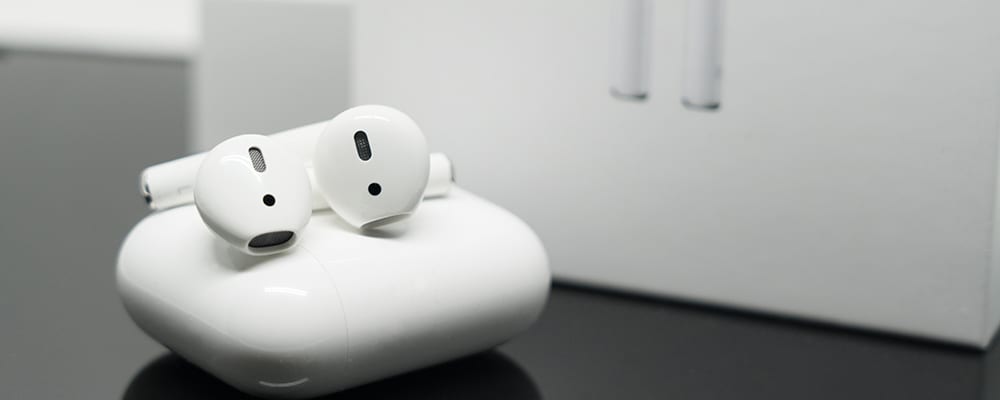A digital signal processor, or a DSP as it's more commonly known, is an important element of much of modern audio equipment. You've likely used a product – or even use one regularly – that includes a digital signal processor.
As with a lot of the technology that's inside our speakers, earphones, or phones, it's unlikely that most people know what this highly important component is, let alone what it does. If you've come here, you're curious to know what a DSP is. Let's get onto the important information about digital signal processors, so you can know what they are and how they work. Let's get started.
What is a Digital Signal Processor?
 As the name suggests, a DSP is a form of a processor, similar to processors that you'd find in laptops or computers but with a very different purpose. Like other processors, a digital signal processor is usually incorporated into a chip and then placed inside a piece of technology, such as a smartphone, headphones, or a smart speaker.
As the name suggests, a DSP is a form of a processor, similar to processors that you'd find in laptops or computers but with a very different purpose. Like other processors, a digital signal processor is usually incorporated into a chip and then placed inside a piece of technology, such as a smartphone, headphones, or a smart speaker.
A digital signal processor aims to deal with digital signals. The most common form of digital signals that a DSP deals with are audio signals. That's why a digital signal processor is so important for modern headphones, earphones, and speakers. You'll find one inside your AirPods, for example, as well as inside your Amazon Echo.
The DSP tends to decode digital audio files. That's why you're able to listen to an MP3 or a Wav file on your iPhone. Without a DSP, these signals wouldn't be processed, meaning that you wouldn't be able to listen to the music. The way DSPs work is complex. But in layman's terms, it involves adding and subtracting - only at an incredibly quick speed.
Digital signal processors are responsible for more than just transforming an MP3 file into a piece of audio that you can then listen to. They're an important element of speaker recognition software, too. Also, wireless headphones rely upon digital signal processors for lots of functions too. They're able to turn the signals sent through Bluetooth from your phone or laptop back into audio signals. This is by processing the codecs that the Bluetooth technology sends.
DSPs are all around you. They're in almost any modern audio device in some capacity. If it's capable of playing or using digital audio, then it needs a DSP to take care of the processing. There's no way of getting around it. Digital signal processors are an important part of your life.
What is a DSP Composed Of?
 Digital signal processors are primarily composed of four main components. The size of these components and their capabilities will differ depending on their purpose. For example, some DSPs are designed for a few well-defined tasks. Then others are multi-tasking digital signal processors. Of course, if they've got to take care of lots of tasks, they'll need to have more complex components inside them that can do these tasks.
Digital signal processors are primarily composed of four main components. The size of these components and their capabilities will differ depending on their purpose. For example, some DSPs are designed for a few well-defined tasks. Then others are multi-tasking digital signal processors. Of course, if they've got to take care of lots of tasks, they'll need to have more complex components inside them that can do these tasks.
Generally, a digital signal processor will include components for program memory, data memory, a compute engine, and ports for input and output.
The program memory component of a DSP is where all the important programs are located. This is what the processor requires to process the data that is sent to the DSP.
The data memory also is an important storage component. But instead of programs being stored here, it's the information that you find in the data memory component.
Next is the compute engine. As you'd expect from the name, this is the key element of the digital signal processor that actually does the processing. It withdraws the information from the data memory and the programs from the program memory. Then it does all the complicated mathematics needed to process both of them.
This is done at an incredibly high speed. It also processes data and information that's sent to the digital signal processor. It then sends it to the appropriate component for storage, either the data memory or the program memory.
The other component that's inside a DSP is the input and output component. This component's role will differ depending on the tasks that the digital signal processor is required to do. This is often represented in the form of ports. This component could be composed of LINK ports, external ports, host ports, timers, and also serial ports.
If you want to know more about the mechanics behind how a digital signal processor works, it's worthwhile to consult some of the valuable resources online that will provide you with further information. As with all processors found within technological devices, it's an extremely complicated process that allows them to work.
It can be very difficult to understand these complexities unless you are well-versed in science, mathematics, or information technology. The most important thing to know is that the components that have just been described work fluidly, quickly and are vital for modern audio equipment.
Why Are Digital Signal Processors Important for Modern Audio Equipment?
If you'd put on a record in the old days, you'd hear the scratches that misuse had put on them. The audio quality would suffer, and that meant your listening experience would suffer too. Then, when you'd plug in a set of old-fashioned headphones, all you would hear was an accurate representation of the audio that you'd be listening to if you ran a record player through a speaker.
There was no enhancement. There was no consistency, either. Any minor scratch or warping of the vinyl could completely change what you heard. In the analog age, listening to music was fraught with difficulties. And that doesn't just go for listening to music - it was the same when speaking on the telephone or talking through a microphone.
We now live in the digital age, where we're fortunate enough to have microprocessors such as digital signal processors that allow us to have a completely different listening experience.
Let's take Apple AirPods. These earbuds are very popular because they're comfortable to wear and offer an excellent listening experience. But, do you realize, that they include digital signal processors that measure your ear canal? That's right. And the whole reason for this is so that you get an enhanced listening experience. The DSPs inside your AirPods instantly assess your ear canals so that they can provide you with optimized sound quality.
 And this isn't just with Apple AirPods. This type of technology is found in countless earphones and headphones. The active-noise cancelation technology that is essential to Bose headphones also includes digital signal processors. That allows them also to enhance your listening experience while the ANC is on.
And this isn't just with Apple AirPods. This type of technology is found in countless earphones and headphones. The active-noise cancelation technology that is essential to Bose headphones also includes digital signal processors. That allows them also to enhance your listening experience while the ANC is on.
Digital signal processors are constantly used to boost bass, balance music, and simply make music sound better. If you decide that you don't like the automatic adjustments that the DSPs make, you can use an equalizer to find a sound that's best suited for you. To do this, however, you'll be using a DSP, as these processors are responsible for digital equalizers.
Any form of surround sound or virtual surround sound that you'll encounter at a cinema or even by just plugging in your simple bookshelf speakers will rely upon digital signal processors. This will create the sense that sound is coming from different places inside the room you're sat in.
But one of the best features of digital signal processors is their ability to compensate for flaws both in music or your speaker or earphone setup. The days of having to listen to a scratched vinyl or having to deal with a song skipping are long gone. Digital signal processors have revolutionized how we listen to audio. And, fortunately, they're here to stay.
There's also a good chance that they'll improve over time. It's difficult to imagine how listening to music might differ from now. You only have to realize just how recent it was we were listening to cassettes, records, and CDs to imagine how different things could be twenty or thirty years from now. Regardless of what happens, you can be certain that digital signal processors will be playing an important part in the evolution of listening to audio.
If you liked the article, please leave your feedback.
